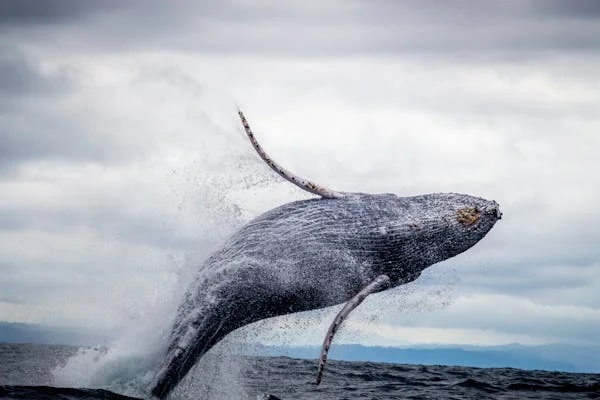Introduction
Blue whales, the largest animals on Earth, are often associated with peaceful, majestic images as they swim through the oceans. However, there are rare and shocking cases where a blue whale has been found severely injured or even bitten in half. Such incidents are extremely rare but have sparked curiosity about the nature of these attacks and the reasons behind them. This article delves into the factors surrounding these rare occurrences and explains the possible causes behind blue whales being bitten in half.
What Is a Blue Whale?
Before diving into the details of the rare incidents involving blue whales being bitten in half, it’s important to understand what makes blue whales unique.
- Size: Blue whales are the largest animals on Earth, with adults reaching lengths of up to 100 feet and weights of up to 200 tons.
- Habitat: These marine mammals are found in oceans worldwide, from the polar regions to the equator, though they are most commonly spotted in deep ocean waters.
- Diet: Blue whales primarily feed on krill, consuming up to 4 tons of krill each day during feeding seasons.
- Life Expectancy: Blue whales can live to be around 70 to 90 years old.
Despite their massive size, blue whales are not the most aggressive creatures. Their gentle nature and peaceful existence make the idea of a blue whale being bitten in half all the more fascinating and troubling.
What Happens When a Blue Whale Is Bitten in Half?
While attacks on blue whales are extremely rare, there have been a few cases of these massive creatures being severely injured, including reports of whales being bitten in half. Such incidents are often difficult to explain, and various theories exist as to the cause of these injuries.
Possible Causes of Blue Whale Injuries
1. Predator Attacks
One of the main theories behind blue whales being bitten in half involves predator attacks, especially from large sharks. Although blue whales are too large for most predators to tackle, some predator species are capable of inflicting severe injuries on them.
- Great White Sharks: Great white sharks are known for their powerful bites, which can cause fatal wounds in other marine animals. While it is rare for a great white shark to attack a blue whale, it is not entirely impossible. A bite from a shark of this size could potentially cause deep lacerations or severe injuries.
- Killer Whales (Orcas): Another possibility is that killer whales, which hunt in pods and target larger animals, could inflict damage on blue whales. Orcas are known to attack and kill smaller whale species, so it is not out of the realm of possibility that they could target a blue whale, though this would be unusual behavior.
2. Ship Strikes
Ship strikes are a major concern for many marine animals, especially whales. Ships traveling at high speeds can strike whales, leading to severe injuries or death.
- Fatal Collisions: Large commercial vessels are often the culprits behind fatal whale strikes. A blue whale caught in the path of a ship could suffer severe injuries, sometimes even resulting in the whale being severed in half.
- Impact on Whale Populations: Ship strikes contribute to the decline in whale populations, especially in busy shipping lanes.
3. Natural Causes
In some instances, a whale’s body may appear to be bitten in half due to natural causes.
- Decaying Bodies: Over time, the body of a dead whale can decompose in such a way that it may appear to be bitten or severed. Marine scavengers such as sharks or other fish could also be involved in the decomposition process, leading to the appearance of bite marks or torn flesh.
- Diseases and Illnesses: Certain diseases can cause weakened immune systems in whales, making them more vulnerable to injury from natural causes.
Real-Life Incidents: Blue Whales Found with Severe Injuries
While rare, there have been several documented instances of blue whales being found with bite marks or severe injuries that suggest an encounter with a predator or a violent event. These cases often involve whale carcasses washed up on beaches or floating in the water.
Case Study 1: Blue Whale Carcass Found with Bite Marks
In one case, a blue whale carcass was discovered with large bite marks on its body. This raised the question of whether the whale had been attacked by a predator. Some marine scientists speculated that the bite marks could have been caused by a great white shark or orcas, though the exact cause of the injury was never confirmed.
Case Study 2: Ship Strikes and Injuries
Another instance involved a blue whale that was found with significant damage to its body, potentially caused by a ship strike. The injuries appeared to be caused by the sharp edges of a ship’s hull, leading to severe lacerations on the whale’s skin and body. The whale did not survive the injuries.
Case Study 3: Natural Causes and Decomposition
There have also been cases where blue whale carcasses were found severely decomposed, and the body appeared to be bitten or torn in half. Upon closer inspection, it was determined that the whale had not been attacked by a predator but had instead been subject to natural processes of decomposition in the ocean, aided by scavengers.
Understanding the Size and Power of Blue Whales
To understand the rarity of such attacks, it is essential to comprehend the sheer size and power of blue whales.
| Attribute | Blue Whale |
| Length | Up to 100 feet (30 meters) |
| Weight | Up to 200 tons |
| Diet | Primarily krill |
| Life Span | 70 to 90 years |
| Habitat | Deep ocean waters around the world |
Size Comparison:
Blue whales can grow up to 100 feet long, making them the largest animals to have ever lived on Earth. Their massive size deters most predators from attacking them.
Physical Defense:
Blue whales are equipped with powerful tails and strong skin, which help them defend themselves from smaller predators. However, larger marine predators like orcas and great white sharks can occasionally pose a threat, albeit rarely.
The Role of Marine Ecosystem in Attacks
The marine ecosystem plays a significant role in understanding why some whales, particularly blue whales, are occasionally attacked or injured.
- Predator-Prey Relationships: Most predator-prey relationships in the ocean are based on size and strength. Smaller marine creatures tend to be the preferred targets for large predators, and while blue whales are massive, they are not immune to attacks in rare circumstances.
- Shark Feeding Habits: While sharks do not generally target blue whales, their bite patterns are designed to tackle animals like seals, sea lions, and smaller fish, which could be a sign of an unusual event when they do target such a large prey.
Conservation Efforts to Protect Blue Whales
Blue whales are protected by international conservation laws due to their vulnerable status. However, various threats still pose risks to their survival, including ship strikes, environmental changes, and human activity.
| Threats to Blue Whales | Description |
| Ship Strikes | Collisions with large vessels can cause fatal injuries. |
| Pollution | Polluted oceans disrupt whale habitats. |
| Climate Change | Rising ocean temperatures affect whale feeding areas. |
| Hunting | Though banned, illegal hunting still affects populations. |
- Whale Conservation Programs: Many organizations are dedicated to monitoring blue whale populations and advocating for measures to reduce ship strikes and protect the whale’s habitat.
- Marine Protected Areas: The creation of marine protected areas is one way to mitigate the risk of ship strikes and preserve safe zones for blue whales to live and breed.
How Can We Help Protect Blue Whales?
Protecting blue whales requires both public awareness and international cooperation. Here are some ways to help protect these majestic creatures:
- Avoid Ship Strikes: Promote the use of slower speeds in shipping lanes and establish shipping routes that avoid whale habitats.
- Reduce Pollution: Efforts to reduce pollution and preserve ocean habitats can help blue whales thrive.
- Support Conservation Efforts: Support marine conservation organizations that work to protect blue whale populations.
Conclusion
While the idea of a blue whale being bitten in half may seem extraordinary, it is important to understand the underlying causes and factors that can lead to such injuries. These rare occurrences are often the result of attacks by large predators, ship strikes, or natural processes. The vast majority of blue whales, however, live peaceful lives, far removed from such violent encounters. Understanding these incidents can help improve efforts to protect blue whales and ensure their survival in our oceans for future generations.
FAQs
What causes blue whale injuries?
Ship strikes are the most common cause of injuries to blue whales.
Can sharks bite a blue whale in half?
It’s extremely rare for sharks to bite a blue whale in half due to their size.
What threats do blue whales face?
Blue whales face threats from ship strikes, pollution, and climate change.
Are blue whales endangered?
Yes, blue whales are endangered due to hunting and environmental threats.
How can we protect blue whales?
Support conservation efforts, reduce pollution, and advocate for safe shipping practices.
Do killer whales attack blue whales?
Killer whales rarely attack blue whales due to their large size.






